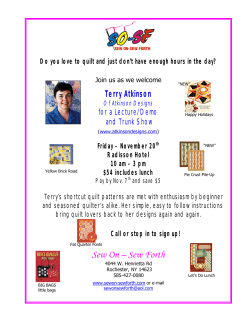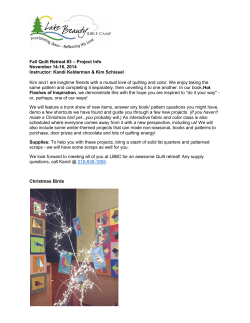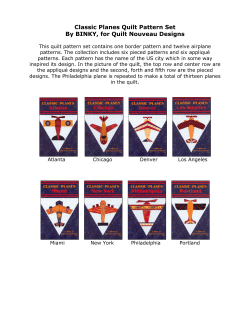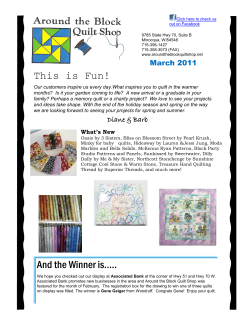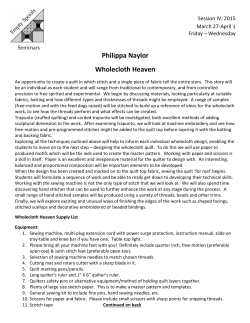
Activity 8 Children’s rights picture quilt Aim:
CORE UDHR ACTIVITIES Activity 8 Children’s rights picture quilt Aim: To encourage children to learn about and understand rights contained in the United Nations Convention on the Rights of the Child (UNCRC) by making a children’s rights picture quilt illustrating key articles of the Convention. Time: 1-2 hours. Age: 7+. What you need: United Nations Convention on the Rights of the Child summary version (on the CD, enlarge and display or present on a PowerPoint); United Nations Convention on the Rights of the Child statements (on the CD, cut up and put in box or hat); Children’s right picture quilt template (on the CD, one per group). Each pair of children need a piece of fabric or paper as per template (on the CD); a large rectangle of fabric or paper for backing for quilt. What to do Briefly introduce the United Nations Convention on the Rights of the Child (UNCRC). Tell the class that they are going to find out about these rights and show them in a big display. Rights of the child Explain that after the Universal Declaration of Human Rights was agreed, a number of international laws were created to protect the rights of particular groups of people. One of these laws protects the human rights of children. It is called the United Nations Convention on the Rights of the Child (UNCRC) and was drawn up by the world’s leaders more than 20 years ago. It spells out the rights of the world’s two billion children and young people under the age of 18, and their need for special care and help. It says what governments should do to help fulfil these rights. It became part of international law in 1989. Nearly all of the countries in the world have promised to make the rights in the UNCRC real for children. or two words that would sum up what their statement is about? Pairs should now work out a simple mime to represent their statement. Other display ideas Instead of a quilt, children could illustrate their UNCRC statements by: •painting on tiles; •sculpting little clay or plaster figures for each right; •making a collage of fabrics or embroidered squares; •painting on silk with gutta or outliner and fabric inks; •making linocut prints. The Convention provides young people with over 40 rights, and says every child has the right to live and to grow up; to be protected from harm, danger and bad treatment; to enjoy family life, health care and education; to be treated fairly; to have their own ideas listened to. Share the summary version of the Convention with the class (on the CD). Miming Divide the class into pairs. Pass round a hat or box containing the 16 UNCRC statements. Explain that these are just a selection of the rights that children have. Each pair should pick out a statement without looking (as in a lucky dip), read it and discuss its meaning (seeking help if necessary). Can they think of one © Paula Cox LEARNING ABOUT HUMAN RIGHTS IN THE PRIMARY SCHOOL Activity 8 Children’s rights picture quilt continued See CD resources for quilt instructions Quilt making Next, ask them to make a sketch on scrap paper to show what their statement is about (examples below). Then they copy their sketch so that it fills the whole square on their sheet of paper or cloth, and colour it in beautifully. Next, they should write the words on their statement onto the rectangle at the top of their sheet. When ready, all the children should form a circle. In turn ask pairs to perform their mime. Challenge the rest of the class to guess what right is being portrayed. Then ask the pair performing to read out their statement and show their picture. quilt – get the children to help. (See Children’s rights picture quilt template sheets for guidance). The children’s pictures, their UNCRC statements and the UNCRC heading should be glued or sewn onto a large backing sheet of paper or cloth. This can be presented in a school assembly about the UNCRC, with pictures projected on PowerPoint while the artists are performing their mimes and reading out their rights. Their children’s rights picture quilt can also be put on public display in the school, perhaps on 20 November (UN International Children’s Rights Day). The teacher should write ‘UN Convention on the Rights of the Child’ as a big title to glue across the top of the Every child has the right to meet their friends and join groups. Every child has the right to speak their own language and practise their own religion. Source: Adapted from Our World Our Rights, Activity 6. LEARNING ABOUT HUMAN RIGHTS IN THE PRIMARY SCHOOL
© Copyright 2025
